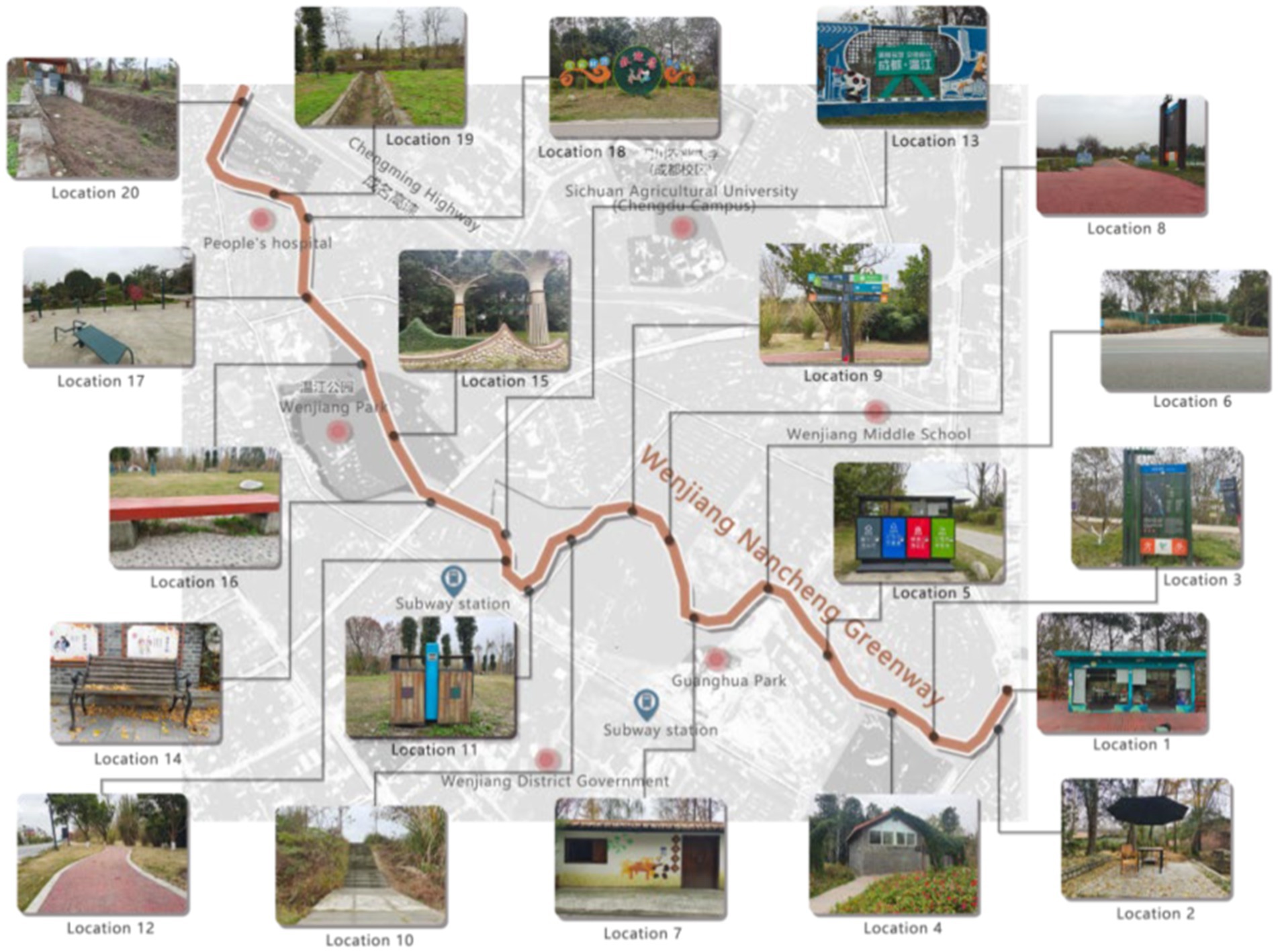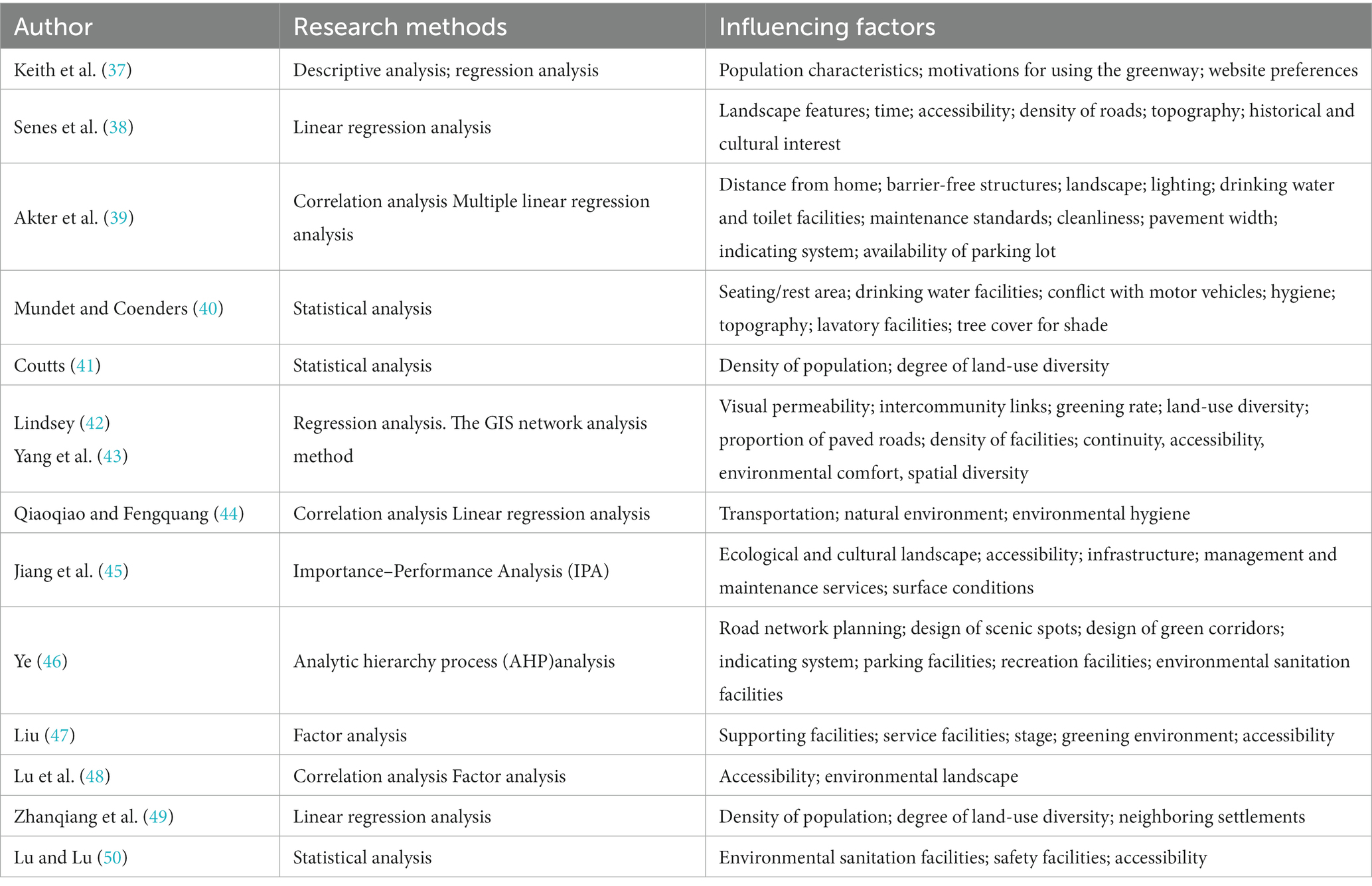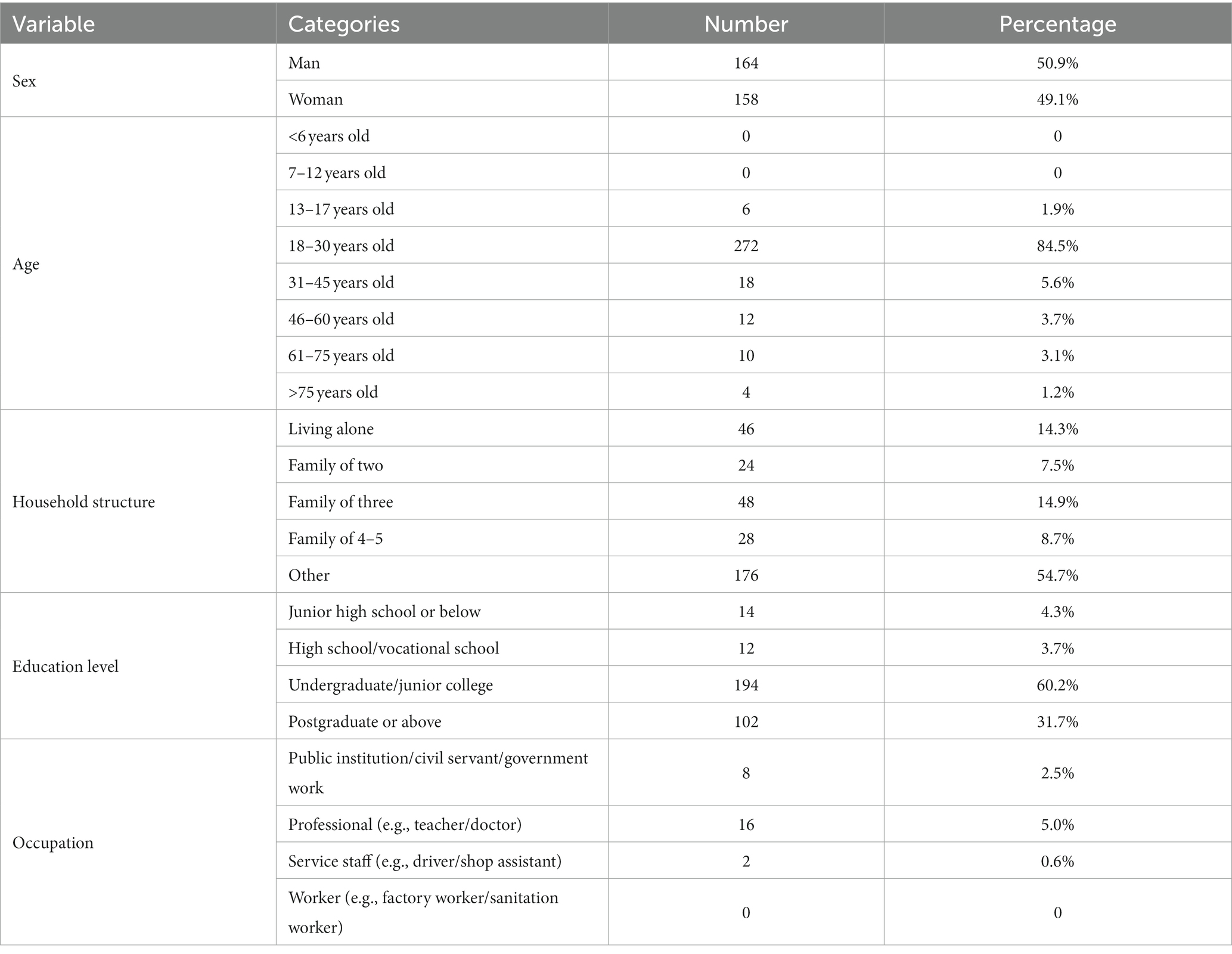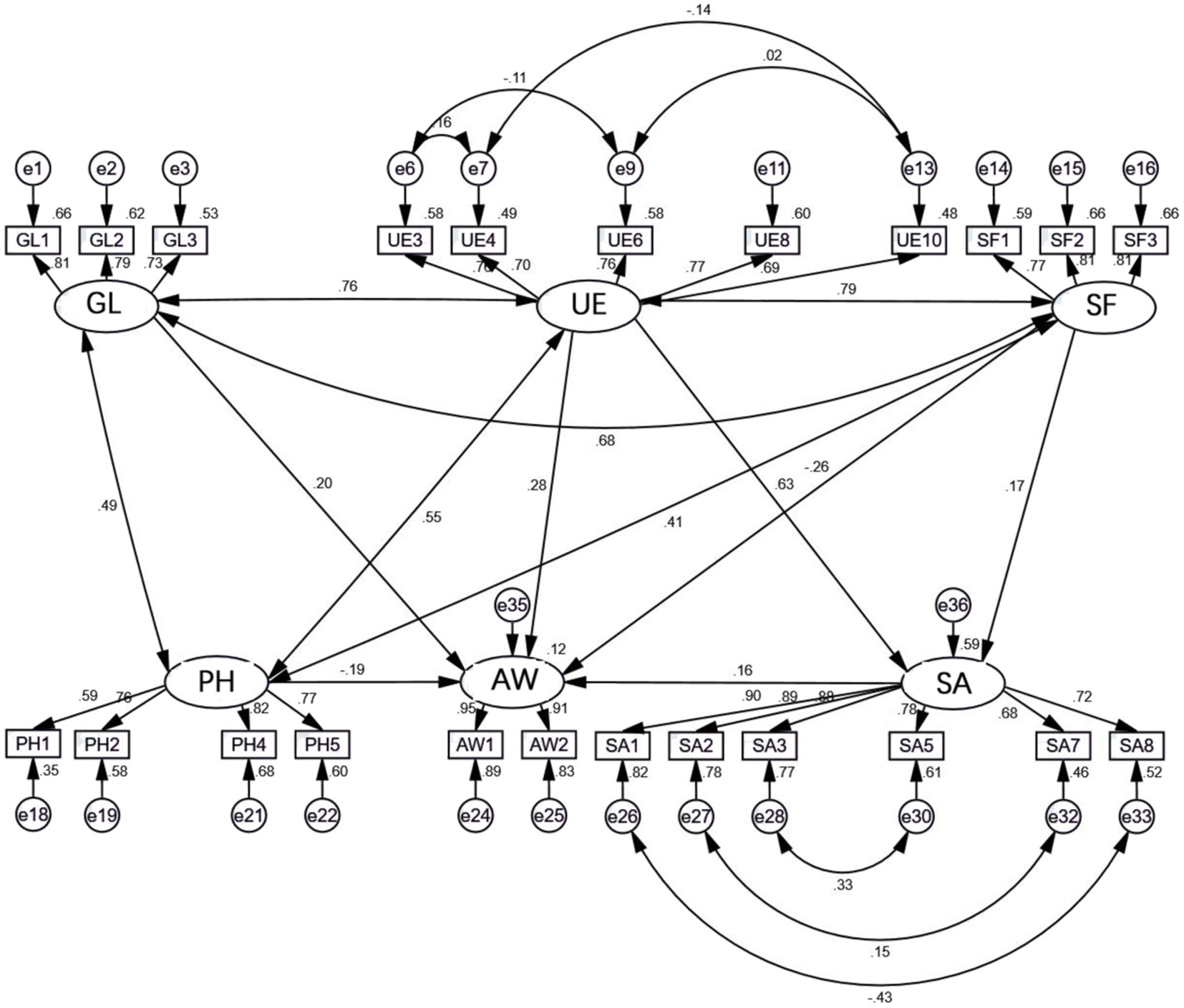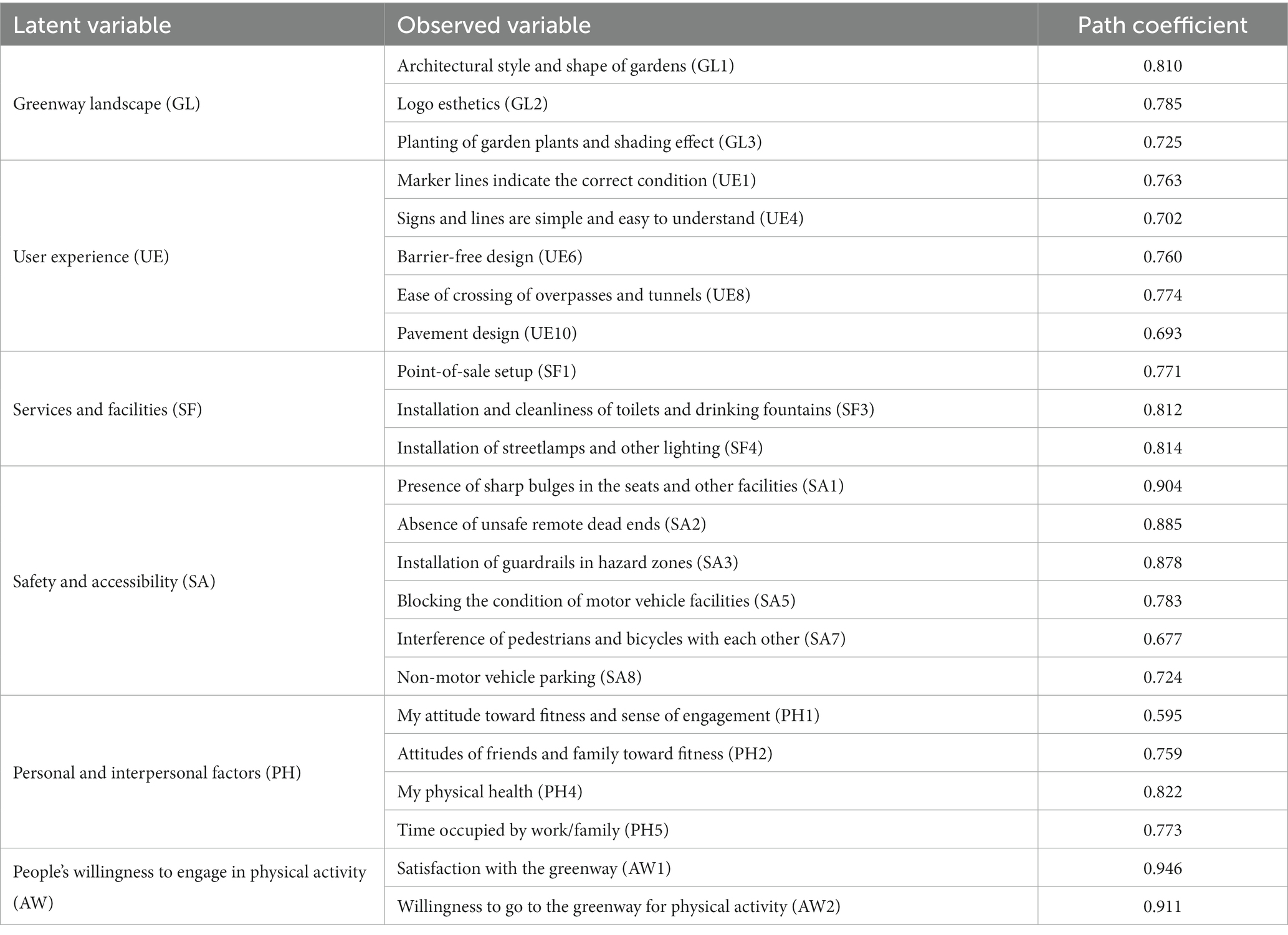- College of Landscape Architecture, Sichuan Agricultural University, Chengdu, China
Public health problems caused by rapid urbanization have attracted increasing amounts of attention. Existing studies show that improving the frequency and duration of physical activity among urban residents can effectively reduce their disease risk. A community greenway, as a green space for public activity directly serving community residents, is one of the best spatial place for bringing health benefits to people. Although the scale and scope of greenway construction have been increasing in recent years, the utilization rate of some greenways is not high for various reasons, restricting the extent to which people engage in healthy physical activities in greenway spaces. In this study, the greenway of Nancheng Community in Wenjiang District, Chengdu city, China was selected as the object of study, and structural equation modeling was conducted to explore the objective environmental factors and individual characteristics acting as barriers to use of the community greenway by the population for physical activity. The results show that user experience, the greenway landscape, and safety and accessibility are important factors that restrict people’s willingness engage in physical activity in the community greenway environment. The results of this study provide a direction for further consideration of ways to enhance people’s willingness to make use of greenways for physical activity, and further provide a theoretical basis for the healthy design and transformation of community greenway spaces.
1. Introduction
Rapid urbanization has brought an increasing number of public health problems to the attention of the public and has increased health risks among the population in several ways, especially in the areas of mental illness (1, 2), chronic diseases such as cardiovascular disease (3, 4), and general health (5–7). Empirical studies of environmental health and public health indicate that increasing the frequency and duration of physical activity can effectively reduce the risk of these diseases among urban residents. For example, increasing physical activity as a form of leisure can improve the health of the population (8), enhance physical and mental health (9), and also help to reduce stress, regulate emotions, and improve cognition (10–13).
Green open space is an important feature of a healthy outdoor living environment and an important type of space for the promotion of people’s participation in physical activity. Research has found that the number of parks in the vicinity of an area of residence is directly proportional to the intensity of physical activity engaged in by its population, and the provision of different types of environment within a park can support different types and levels of physical activity (14). Residents’ personal attributes also play a moderating role in the relationship between green space and recreational physical activity (15). Some scholars have also focused on the relationship of green public space with physical activity among different groups: for example, community parks and trail length are positive predictors of increased physical activity among older adults (16), while street greenways also result in increased physical activity among older adult patients and in the creation of a healthy aging environment (17).
As an indispensable linear form of green open space and a component of an urban green space system (18, 19), greenways provide residents with a suitable space for slow walking and can be used as sports venues (20, 21); they therefore have the health-related effects of relieving mental pressure, increasing physical activity, and promoting social interaction. By creating an ecologically friendly environment, greenways can bring people closer to nature to relieve mental stress (22, 23), provide a walking environment for the promotion of physical activities such as walking, cycling, and stretching (24, 25), and form a network of green channels to connect different communities, thereby stimulating public interaction (26). According to empirical research, the above benefits are more evident in the case of greenways connecting neighboring communities (27, 28), which can positively impact and restore the mental state and physiological capabilities of residents (29), especially those of older adults in the community (30, 31). Greenways connecting neighboring communities affect the amount of exercise taken by residents, mainly through the provision of a pedestrian environment enabling community residents to take control of their engagement in physical activity; this benefits the amount of exercise they take, which in turn improves the health of residents (32). Thus, the features of greenways in the built environment can positively affect the intensity of residents’ physical activity (33).
Although the scale and scope of greenway construction have been increasing in recent years, the utilization rate of some greenways in reality is not high, as a result of many subjective or objective restrictions limiting individuals’ participation in healthy physical activities on the greenway space; this reduces the quality of recreation services provided by the greenway. Among these restrictions, intrapersonal, interpersonal, and structural restrictions all affect people’s use of greenways for recreational activities (34), and generally, these three factors impose decreasing levels of constraint, in the order of mention (35). Previous studies have proved that preference, time, travel costs, and geographical distance are the main factors restricting recreational activities in urban green spaces (36), but few researchers have discussed the factors specific to community greenways regarding the willingness of people to engage in physical activity.
Therefore, on the basis of a literature review and questionnaire-based survey, the aim of this study was to construct a model of the factors acting as restrictions to the use of the community greenway for physical activity by the population. Taking the greenway of Nancheng Community in Wenjiang District of Chengdu as the object of this social investigation, structural equation modeling was used to verify the variables identified, with the aim of exploring the objective environmental factors and individual characteristics that act as restrictions to use of the community greenway for physical activity among the population, and of exploring the strength of each influencing factor (Figure 1).
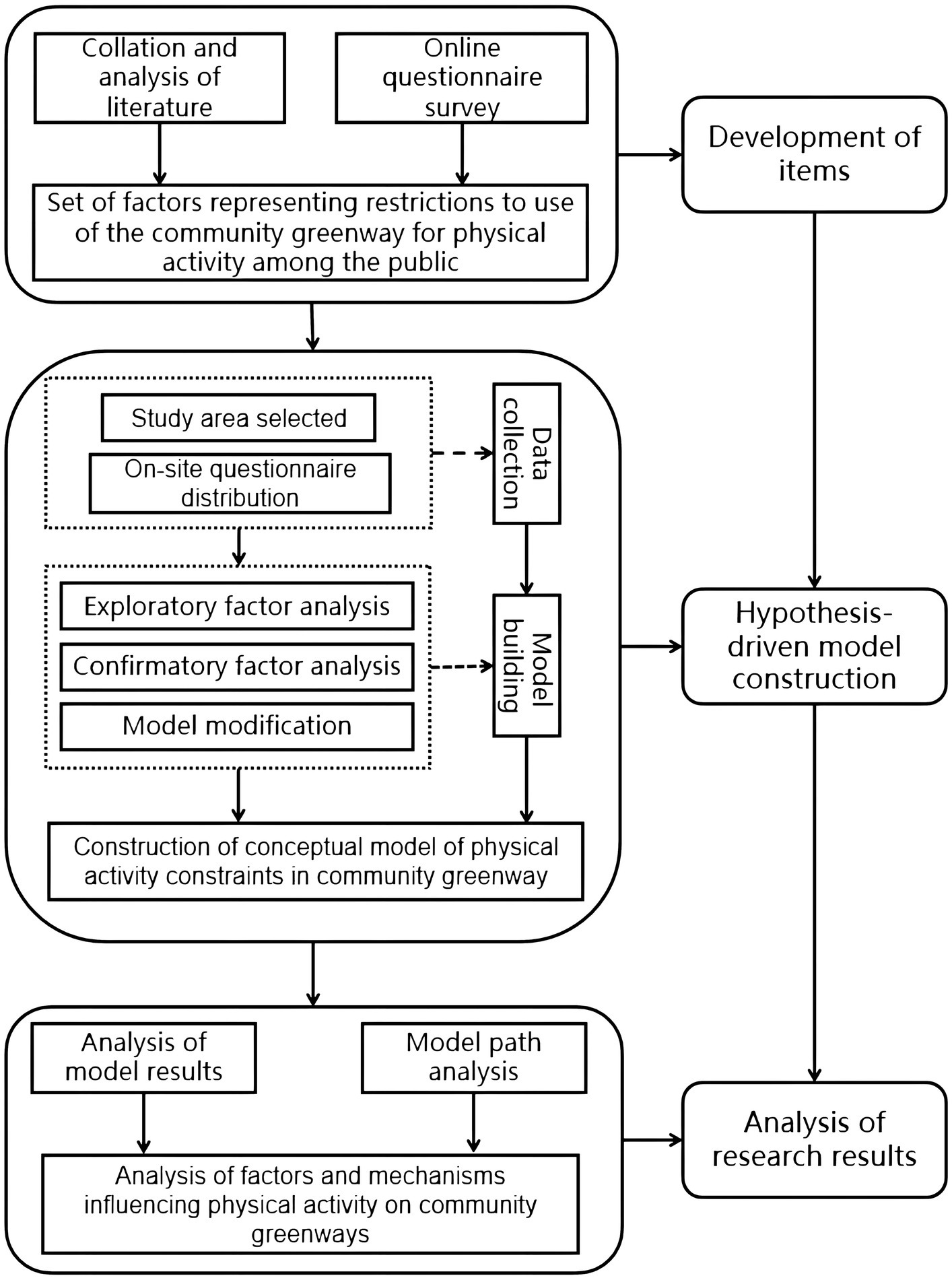
Figure 1. Flow chart for this study of restrictions to use of community greenways by the public for physical activities.
2. Methods
2.1. Site selection
The South City Community Greenway in Wenjiang District, Chengdu, China was selected as the research object for this study. This 87-km-long greenway connects schools, metro stations, bus stops, hospitals, and other public services constituting a 15-min living circle, providing a very good spatial place and a high-quality space for green and low-carbon travel, grocery shopping, leisure and sports, and neighborhood interaction for residents in the surrounding area; it is one of the most frequently used greenways in Chengdu. A total of 20 residential areas, clusters, and compounds within 1 km of the South City Community Greenway Station and its surrounding areas were selected for inclusion in this study (Figure 2).
2.2. Design of the questionnaire
2.2.1. Initial selection of items
Following extensive reading and collation of literature related to greenways and constraints on them, 14 articles with strong relevance to the content of this study were identified. In-depth interpretation and analysis of these was carried out; relevant elements mentioned in the literature pertaining to the characteristics of greenways and personal subjective factors that restrict the willingness of the public to make use of them were extracted, and an initial set of factors constraining public use of community greenways was constructed (Table 1). This initial selection of factors included five factor dimensions as latent constructs: greenway landscape (GL), service facilities (SF), personal and interpersonal factors (PH), experience of use (UE), and accessibility and safety (SA). Each dimension contained several specific items, for a total of 32 observed variables. The five latent variables could not be measured through direct observation in practice, but the observed variables could be; therefore, the latent constructs in the factor system were measured via the corresponding observed variables.
2.2.2. Optimization of items
Through interviews with people using the greenway and relevant experts, items were added to and removed from the set of potential influencing factors was added, items were categorized, and the latent variable of personal and interpersonal factors (PH) was added. On the basis of the initial set of items for evaluation, the “Questionnaire on Constraints on Physical Activity Among Community Greenway Users” was developed to optimize measurement of the relevant items, taking into account the purpose of this study. Responses were given on a Likert scale, with respondents indicating the strength of each of the barriers as one of five levels: no effect, weak effect, average effect, strong effect, or very strong effect. Each of the 34 items was evaluated separately. The optimized form of the questionnaire was finally established as shown in Table 2, consisting of 6 latent variables and 34 observed variables (Table 2).
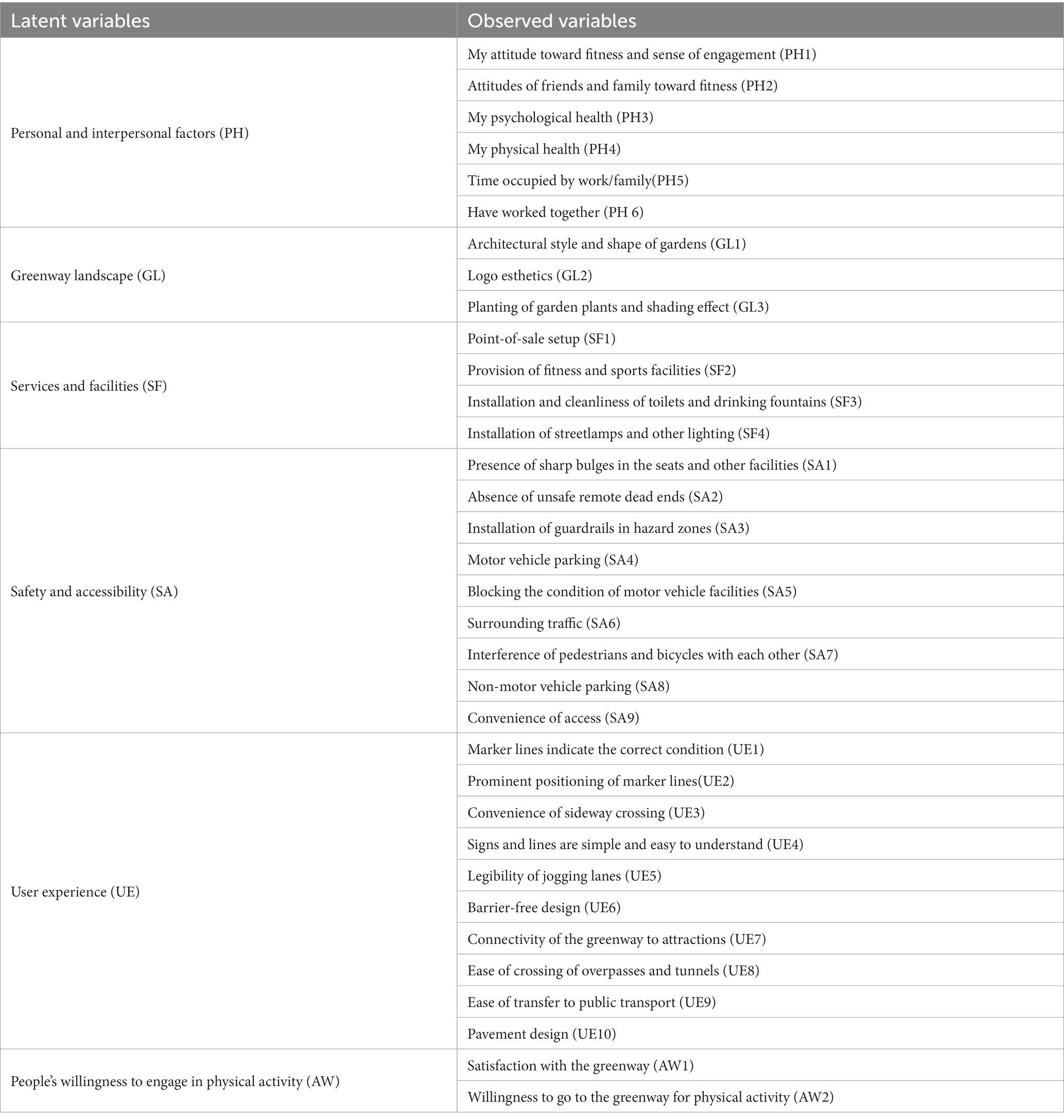
Table 2. Preliminary selection of items and variables for the model of barriers to peoples’ use of the community greenway for physical activity.
2.3. Procedure
The survey was completed between October and December of 2021 by a random sample of participants. For some participants who encountered difficulties in reading and filling out the questionnaire, the survey was administered in interview form and the participants were assisted in filling out their responses according to their opinions. A total of 350 questionnaires were distributed and 322 valid sets of responses were returned, for a valid return rate of 92%. As shown in Table 3, the participants represented a wide range of ages, education levels, and occupations, with a high degree of randomness, ensuring the reliability of the findings of the analysis.
2.4. Statistical analysis
Structural equation modeling (SEM) is a method for the construction, estimation, and testing of models of causal relationship; it is an extension of a variety of multivariate analysis techniques. A structural equation model contains both measurable observed variables and latent variables that cannot be directly observed. SEM can replace multiple regression, path analysis, factor analysis, covariance analysis, and other methods, and enables clear analysis of the effects of individual factors on the entire set of outcomes and the relationships between individual factors. Compared with traditional analysis methods, SEM enables explanation of as much of the variability as possible while providing an understanding of the covariant relationships between variables. There are two types of factor analysis within SEM: exploratory and confirmatory factor analysis. Exploratory factor analysis (EFA) is used to extract the structure of a set of data; CFA is used to validate hypotheses regarding observed and latent variables. In this study, EFA was first conducted to extract the main factors, and CFA was then used to validate the structure of the factors imposing constraints on physical activity on the greenway. On the basis of the structure arising from the CFA results, a model of barriers to physical activity on the community greenway is proposed.
3. Results
3.1. Construction of the conceptual model
3.1.1. Analysis of validity
Before exploratory factor analysis (EFA) is conducted, the data should first be analyzed for reliability and validity. The reliability of the valid data obtained in the present study was analyzed using SPSS 22.0. Cronbach’s alpha coefficient for the standardized items was 0.953, indicating that the reliability of the questionnaire was high. The main tests of validity employed were Bartlett’s test of sphericity and the KMO test. The results are shown in Table 4: the KMO value was 0.885 (KMO > 0.60), indicating that there was no significant difference in the correlation degree of each variable. For Bartlett’s test of sphericity, χ2 = 8533.125, p = 0.000 (p < 0.001), indicating that the collected data for observed variables exhibited good intercorrelation and met the requirements for EFA analysis.
3.1.2. Exploratory factor analysis
Exploratory factor analysis (EFA) was first conducted to extract the dominant factors underlying restrictions to engagement in physical activity on the community greenway. Principal component analysis with varimax rotation was employed to determine the orthogonal factors, and factors with an eigenvalue greater than one were identified. As listed in Table 5, five factors were extracted based on EFA, accounting for approximately 66.26% of the total variance, with factor loadings ranging from 0.409 to 0.821. Common factor 1 represented “safety and accessibility,” explaining 21.94% of the variance; common factor 2 represented “user experience,” explaining 16.48% of the variance; common factor 3 represented “personal and interpersonal factors,” explaining 11.53% of the variance; common factor 4 represented “services and facilities,” explaining 9.09% of the variance; and common factor 5 represented “the greenway landscape,” explaining 6.61% of the variance.
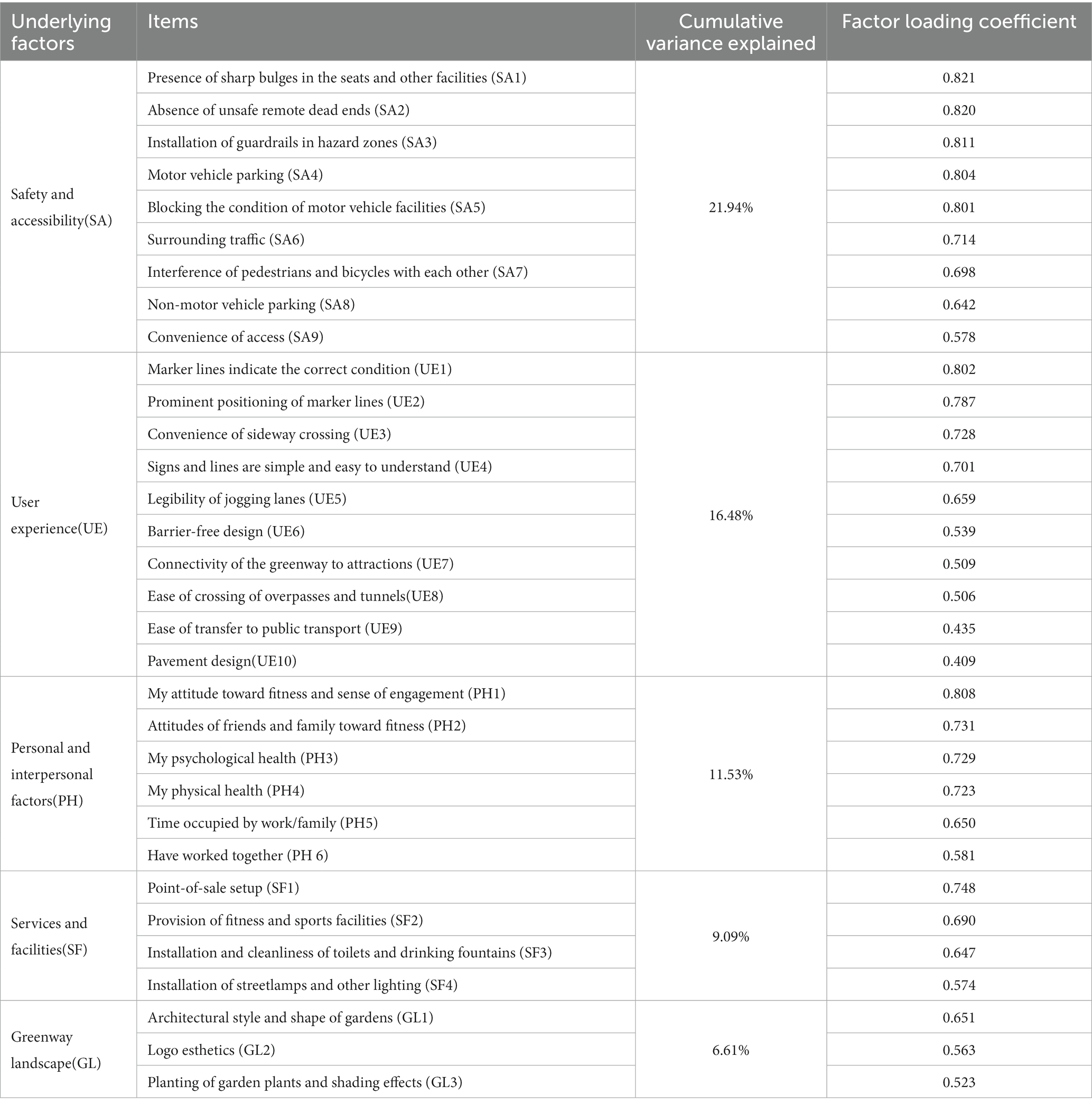
Table 5. Summary of the results of EFA of restrictions to physical activity on the community greenway.
3.1.3. Confirmatory factor analysis
The common factors extracted via EFA were taken as latent variables, and the items falling within these were taken as the corresponding observed variables; a measurement model in the form of a structural equation model was thus established. In order to further test the reliability of the measurement model, confirmatory factor analysis (CFA) was carried out on the measurement model, including reliability analysis and validity analysis. The reliability analysis was conducted by computing Cronbach’s α coefficient for each variable in the measurement model. As shown in Table 6, Cronbach’s α coefficient was greater than 0.8 for each of the six latent variables, and the overall Cronbach’s α coefficient was 0.953, indicating good reliability among the observed variables within each latent variable and among all latent variables, with good internal consistency.
In SEM, in order to test whether the model achieves a good fit, it is generally necessary to conduct statistical analysis by calculating the ratio of the chi-square statistic to the respective degrees of freedom (χ2/DF), the RMSEA, the GFI, the CFI, and other indicators of fit. In this case, χ2/DF = 6.699, and the standard criterion value is 1–3, meaning that this measure indicated that the goodness of fit was not up to standard; RMSEA = 0.673, and this value should be <0.08, also indicating that the goodness of fit was not up to the standard; and GFI and CFI were calculated to be 0.633 and 0.673, respectively, while these two indicators should be >0.9 (Table 7). Therefore, the indicators of goodness of fitness did not reach the standard criteria, indicating that the model fit was inadequate, and the model needed to be adjusted and corrected.
3.2. Construction of the structural equation model
The conceptual structural equation model describing the relationships between the six latent variables is shown in Figure 3. The main specific hypotheses relating to barriers to physical activity in community greenways are presented as follows:
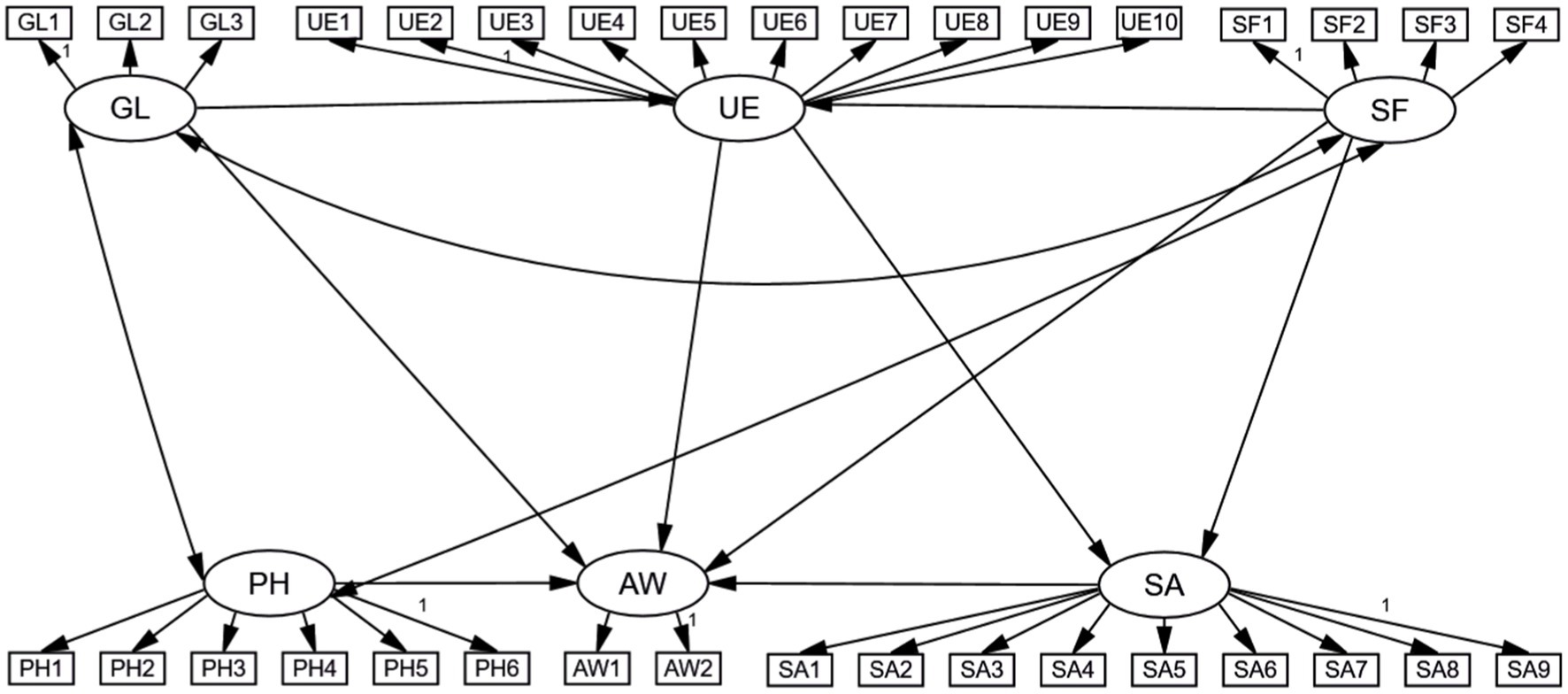
Figure 3. Initial model of factors restricting physical activity on the greenway among the population of the greenway community.
H1: Provision of services and facilities has a positive impact on the willingness of the population to engage in physical activity;
H2: User experience has a positive impact on the willingness of the population to engage in physical activity;
H3: The greenway landscape has a positive impact on the willingness of the population to engage in physical activity;
H4: Safety and accessibility have a positive impact on the willingness of the population to engage in physical activity;
H5: Personal and interpersonal factors have a positive impact on the willingness of the population to engage in physical activity.
3.3. Modifications to the structural equation model and results
The modifications made to the structural equation model were mainly based on the MI (Modification Index) values and t values in the output results. In accordance with the principle of adjusting parameters in order of the associated MI value, from large to small, the observed variable corresponding to each of the relevant residual terms was removed or adjusted in turn under the premise of the model logic. In addition, under the premise that the model logic was reasonable, adjusted paths with a large MI value were added to analyze whether the adjustment was desirable by comparing the fit indices. After the above adjustments to and modifications of the initial model, each model fit index was significantly improved compared with the original model; the model fit is shown in Table 8. After these modifications, the chi-square value for the model was 968.364, with 210 degrees of freedom, and the χ2/DF ratio was 4.611, which is close to 3. Due to the large sample size of the questionnaire, the value was slightly higher, but still fell within acceptable limits. The RMSEA was close to 0.08, and the GFI, AGFI, CFI, IFI, and TLI were also close to 0.9. Again, due to the large sample size, the values deviated slightly, but they were all within the acceptable range. After modification, the overall fit of the model reached an acceptable standard, and a final structural equation model of the barriers to physical activity on the community greenway among the population was determined, as shown in Figure 4.
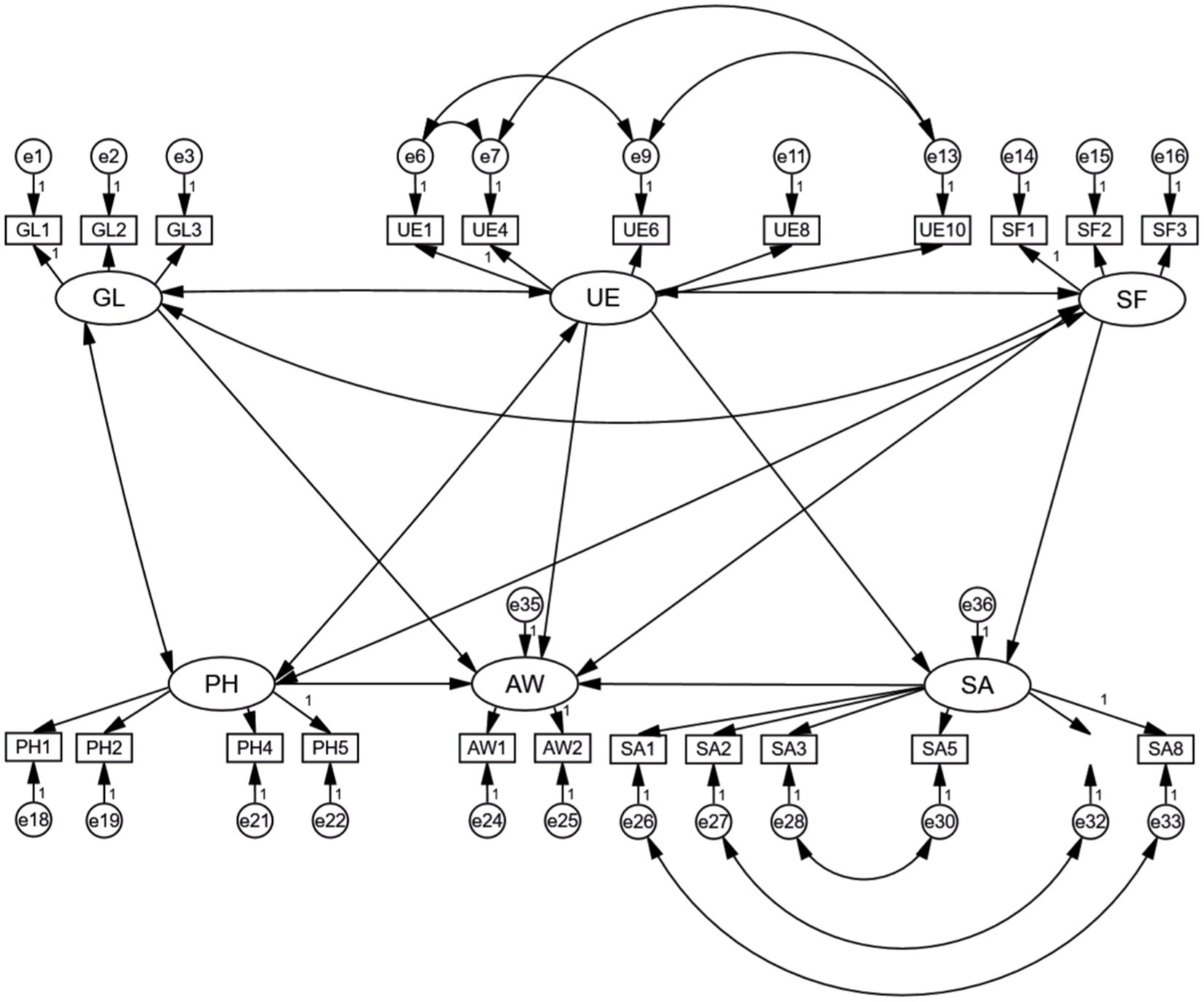
Figure 4. Structural equation model of factors restricting physical activity on Wenjiang Nancheng Greenway.
3.4. Structural equation model path analysis
According to the results of the analysis of the revised measurement model and structural model, the overall goodness of fit of the model was high, and the model was assumed to be reasonable in this study. Therefore, the strengths of the influence between variables could be evaluated using standardized path coefficients, and the research hypotheses proposed above could be tested and analyzed. The results indicated that H2, H3, and H4 were valid: that is, user experience (UE), the greenway landscape (GL), and safety and accessibility (SA) each had a positive impact on people’s willingness to engage in physical activity (AW), with path coefficients of 0.280, 0.205, and 0.163, respectively. However, H1 and H5 were not valid: that is, services and facilities (SF) and personal and interpersonal factors (PH) had no significant positive influence on willingness of the population to engage in physical activity (AW).
3.4.1. Analysis of the weights of influence among variables in the structural model
By analyzing the path coefficients listed in Table 9, it can be seen that in the case of Wenjiang Greenway, Chengdu, China, the ranking of potential variables restricting people’s participation in physical activities in descending order of the weight of their influence was as follows: user experience (0.280) > the greenway landscape (0.205) > safety and accessibility (0.163). Therefore, on the whole, the “user experience” factor had the clearest restrictive effect on physical activity among the population, while the “safety and accessibility” factor had the least restrictive effect. The restrictive effects and influence of “services and facilities” and “personal and interpersonal factors” on physical activity among the population were inconsistent with the hypotheses. In addition, there was a positive correlation between the quality of “user experience” and “services and facilities” and the quality of “safety and accessibility,” with the influence weights of 0.168 and 0.630, respectively, indicating that the influence of user experience on safety and accessibility was greater.
3.4.2. Analysis of the weights of influence among variables in the measurement model
The weights representing the influence of the relationship between each observed variable and the corresponding latent variable can be seen in the model path analysis diagram (Figure 5), as shown in Table 10. Among items relating to the greenway landscape, the weight of influence of each item, ranked in descending order, was: architectural style and shape of gardens (0.810) > logo aesthetics (0.785) > planting of garden plants and shading effects (0.725). In terms of the user experience factor, the ranking of the weight of influence of each item was: ease of crossing of overpasses and tunnels (0.774) > marker lines indicate the correct condition (0.763) > barrier-free design (0.760) > signs and lines are simple and easy to understand (0.702) > pavement design (0.693). Within the factor of services and facilities, the ranking of the weight of influence of each item was: installation of streetlamps and other lighting (0.814) > installation and cleanliness of toilets and drinking fountains (0.812) > point-of-sale setup (0.771). Among the items relating to safety and accessibility, the ranking of the weight of influence of each item was: presence of sharp bulges in the seats and other facilities (0.904) > absence of unsafe remote dead ends (0.885) > installation of guardrails in hazard zones (0.878) > blocking the condition of motor vehicle facilities (0.783) > non-motor vehicle parking (0.724) > interference of pedestrians and bicycles with each other (0.677). Among the items falling under personal and interpersonal factors, the raking of the weight of influence of each item was: my physical health (0.822) > my recent physical condition (0.773) > attitudes of friends and family toward fitness (0.759) > my attitude toward fitness and sense of engagement (0.595). Finally, among items relating to people’s willingness to engage in physical activity, the weight of influence of overall satisfaction with the greenway (0.946) was greater than that of their willingness to go to the greenway for physical activity (0.911).
4. Discussion
4.1. Objective constraints on the willingness of people to engage in physical activity on community greenways
In terms of objective environmental characteristics, previous studies have mostly explored the correlation between the environmental characteristics of public green spaces and their use for leisure activities from the perspective of promoting people’s engagement in leisure activities; in contrast, this study focused on the influencing factors and mechanisms that act as restrictions preventing people from using community greenways to engage in more physical activities. In this study, safety and accessibility were found to be important factors and mechanisms restricting people’s use of community greenways for physical activity. In terms of accessibility, the more distant and less accessible a community greenway is from where residents live, the lower the willingness of people to travel to the greenway for physical activity; reasonable organization of the flow of traffic and the availability of suitable parking spaces for private vehicles also affect residents’ willingness to travel. For instance, Lawrence et al. investigated the effect of urban greenway renovation on people’s engagement in physical activity and sedentary behavior, and concluded that accessibility is an important factor in enhancing people’s willingness to engage in physical activity (51); some scholars have also shown that as distance increases, the frequency of green space use decreases, leading to a decrease in the probability of residents’ using green space for physical activity and their willingness to do so (52–54). In terms of safety, existing studies have focused on the differences between different types of environments in terms of the perceived safety of users (55) and the correlation between the configuration of visual elements and users’ perceived safety (56), while some scholars have confirmed through empirical studies that safety can have a significant impact on people’s willingness to engage in physical activity and on the benefits of physical activity (57, 58). In this study, it was found that the presence of hidden safety risks at recreational sports facilities, a low sense of security created by activity spaces, and imperfect safety measures in dangerous areas are important barriers to use of community greenways for physical activities. This study also revealed the aspects of the greenway landscape that act as restrictions to people’s use of community greenways for physical activities and the mechanisms by which these restrictions act. A single type of greenway landscape and poor quality of the landscape environment are important factors that restrict people’s access to greenways for physical activity. Zhang and colleagues explored the influence of the greenway landscape environment on users’ leisure activities through machine vision, but their study found that the environmental characteristics of the greenway do not affect the distribution of leisure activities engaged in (59). In addition, this study found that when the greenway landscape does not reflect the esthetic philosophy and values of the users, this will greatly constrain users’ willingness to engage in physical activity. The findings of this study are similar to those of previous studies: for example, Junga et al. demonstrated that greenway landscape features are positively associated with users’ perceived and preferred experiences, thereby influencing users’ willingness to engage in physical activity (60). Similarly, Bao et al. showed that satisfying the demand for physical activity in neighborhood spaces through the proper configuration of neighborhood spatial and environmental features is conducive to enhancing people’s willingness to engage in physical activity (61). According to the results of this study, services and facilities do not have a constraining effect on people’s willingness to engage in physical activity in community greenways: i.e., the installation and distribution of services and facilities in community greenways does not restrict people’s willingness to engage in physical activity in these spaces. This contradicts previous studies, which have shown that both greening rates and the number of neighborhood fitness facilities can promote residents’ engagement in recreational physical activity and willingness to engage in physical activity (62). For example, Zhai et al. explored the effect of the configuration of park facilities on the intensity of physical activity among older adults, and the study confirmed a significant correlation between the intensity of physical activity and the type and quality of the configuration of park facilities (63). Additionally, Jenny et al. demonstrated that the upgrading of park services helps to increase visitors’ willingness to engage in physical activity and the vitality of the spatial environment (62).
4.2. Subjective constraints on the willingness of people to engage in physical activity on community greenways
In terms of subjective personal factors, previous studies have mostly started from the personal characteristics of users to explore the relationship between their personal attributes, such as gender, age, and occupation (64), and the use of green public spaces; in contrast, this study explored the mechanisms underlying factors hindering users’ willingness to engage in physical activity from the perspective of users’ physiological, psychological, and interpersonal characteristics. This study found that there was no inhibitory relationship between the personal and interpersonal characteristics of users and people’s intentions to engage in physical activity on community greenways, indicating that users’ individual characteristics and interpersonal relationships did not act as restrictions preventing them from going to the greenway for physical activity. This is not in line with the results of existing studies: in terms of the individual characteristics of residents, it has been demonstrated that older adults are more likely to exercise on greenways than younger people, and that greenways have important health benefits for middle-aged and older adults who are exposed to health risks. In addition, residents with higher levels of education, higher annual income, and good health status use greenways more frequently and report higher willingness to engage in physical activity, so these characteristics are likely to promote the improvement of physical activity levels through the use of greenways (65). In terms of peer relationships, Zhu et al., in considering the moderating effects of social support in the relationship between neighborhood green spaces and residents’ engagement in physical activity as a form of leisure, found that an increase in the number of exercise-loving friends among residents would only enhance the positive effect of greening rate, but in turn would weaken the positive effect of increasing the availability of fitness facilities on the degree of engagement in physical activity for leisure (66). This study also revealed that personal experience of greenway use is an important factor that hinders users’ willingness to engage in physical activity. Improving user experience and satisfaction with public space can enhance users’ willingness to engage in physical activity (67). Zhao et al. demonstrated that the subjective perception of humanized space has a direct impact on the duration of physical activity among the public, while the connectivity of the destination and the degree to which the landscape is maintained have an indirect impact on the level of physical activity among the public via the subjective perceptions and user experience of users (68).
5. Conclusion
With a focus on restrictions, this study explored the factors influencing people’s willingness to engage in physical activity on community greenways, indicating that community greenways can provide support for community residents in the form of a space for them to carry out healthy physical activity and daily leisure activities; however, there are also many factors restricting such participation. Adopting a field investigation methodology along with theoretical modeling of hypotheses regarding the factors restricting people’s use of community greenways for physical activity, an empirical study was conducted, taking Chengdu community greenways as the object of research to explore the correlations of the landscape, the safety and accessibility of greenways, and the user experience with people’s intentions to engage in physical activity. The results of the analysis of the effects of services and facilities, and of individual and interpersonal factors, showed that although the data observed were inconsistent with the hypotheses, these factors still have certain constraining effects on people’s willingness to engage in physical activity.
This study has several limitations. First, the empirical investigation reported in this article was conducted in the early winter season. Due to the specific limitations of the season, the number and type of interviewees was insufficient, and the collected data (and thus the results of the analysis) were not sufficiently representative enough of users during other seasons. In addition, all questionnaires were designed with the support of a large body of literature, including expert interviews and pre-research. However, the ways in which certain items were expressed in the final questionnaire may have been slightly obscure to some non-professionals, resulting in incomplete understanding of the full intention of some items of the questionnaire.
Data availability statement
The original contributions presented in the study are included in the article/Supplementary material, further inquiries can be directed to the corresponding authors.
Author contributions
EF provided the research ideas and formulated the overall research objectives, reviewed the literature in the early stage of the experiment, participated in the research and investigation process during the research process, guided and participated in the article writing process. XD conducted the field survey, participated in the analysis of the questionnaire and the data, and was responsible for writing the results, discussion and summary of the paper. YW prepared the preliminary questionnaire, and participated in the field survey and the distribution, sorting and analysis of the questionnaire. LL participated in the field investigation of this study and the writing and translation of the article. YX participated in the field investigation and writing and translation of the study. ML participated in the writing and translation of the article. ZZ participated in the writing and translation of the article. JD guided the writing of this paper and provided help with the research methods and ideas. XnL participated in the writing and translation of the study, and participated in the experimental preparation process of the study. XiL provided theoretical guidance for this study and provided funding.
Conflict of interest
The authors declare that the research was conducted in the absence of any commercial or financial relationships that could be construed as a potential conflict of interest.
Publisher’s note
All claims expressed in this article are solely those of the authors and do not necessarily represent those of their affiliated organizations, or those of the publisher, the editors and the reviewers. Any product that may be evaluated in this article, or claim that may be made by its manufacturer, is not guaranteed or endorsed by the publisher.
Supplementary material
The Supplementary material for this article can be found online at: https://www.frontiersin.org/articles/10.3389/fpubh.2023.1169728/full#supplementary-material
References
1. Pun, VC, Manjourides, J, and Suh, HH. Close proximity to roadway and urbanicity associated with mental ill-health in older adults. Sci Total Environ. (2018) 658:854–60. doi: 10.1016/j.scitotenv.2018.12.221
2. Sarah, SE, and LaJoie, AS. Influence of built environment quality and social capital on mental health of residents of assisted living communities in Louisville, Kentucky. Gerontol Geriatr Med. (2018) 4, 4:5900. doi: 10.1177/2333721418795900
3. Patino, JE, Hong, A, Duque, JC, Rahimi, K, Zapata, S, and Lopera, VM. Built environment and mortality risk from cardiovascular disease and diabetes in Medellín, Colombia: An ecological study. Landsc Urban Plan. (2021) 213:104126. doi: 10.1016/j.landurbplan.2021.104126
4. Zheng, Z, Zhang, P, Yuan, FZ, and Bo, YQ. Scientometric analysis of the relationship between a built environment and cardiovascular disease. Environ Res Public Health. (2022) 19:5625. doi: 10.3390/ijerph19095625
5. Li, SJ, Zhang, JY, Moriyama, M, and Kazawa, K. Spatially heterogeneous associations between the built environment and objective health outcomes in Japanese cities. Int J Environ Health Res. (2022) 2022:1–13. doi: 10.1080/09603123.2022.2159016
6. Haselhoff, T, Lawrence, B, Hornberg, J, Ahmed, S, Sutcliffe, R, Gruehn, D, et al. The acoustic quality and health in urban environments (SALVE) project: study design, rationale and methodology. Appl Acoust. (2022) 188:108538. doi: 10.1016/j.apacoust.2021.108538
7. Engineer, A, Gualano, RJ, Crocker, RL, Smith, JL, Maizes, V, Weil, A, et al. An integrative health framework for wellbeing in the built environment. Build Environ. (2021) 205:108253. doi: 10.1016/j.buildenv.2021.108253
8. Sevild, CH, Niemiec, CP, Dyrstad, SM, and Bru, LE. Motivation and lifestyle-related changes among participants in a healthy life Centre: a 12-month observational study. Int J Environ Res Public Health. (2022) 19:5167. doi: 10.3390/ijerph19095167
9. Mailey, EL, Besenyi, GM, and Durtschi, J. Mental health practitioners represent a promising pathway to promote park-based physical activity. Ment Health Phys Act. (2022) 22:100439. doi: 10.1016/j.mhpa.2022.100439
10. Taani, MH, Strath, SJ, Cho, CC, Ellis, J, and Oh, H. Objective physical activity levels, sedentary time, and muscle mass, strength, and function: impact on physical and mental health-related quality of life in older adults. Res Gerontol Nurs. (2022) 15:131–9. doi: 10.3928/19404921-20220408-01
11. Casali, N, Cerea, S, Moro, T, Paoli, A, and Ghisi, M. Just do it: high intensity physical activity preserves mental and physical health in elite and non-elite athletes during COVID-19. Front Psychol. (2021) 12:757150. doi: 10.3389/fpsyg.2021.757150
12. Alison, K. (2020). Importance of physical activity in physical and mental health. The Brown University Child and Adolescent Behavior Letter.
13. Poppe, L, Deforche, B, Van, CJ, Brondeel, R, Mertens, L, Van, WN, et al. The association between the number of parks near home and levels of physical activity among community-dwelling older adults: a longitudinal study. Cities. (2022) 130:103931. doi: 10.1016/j.cities.2022.103931
14. Wang, XX, and Wu, CZ. An observational study of park attributes and physical activity in neighborhood parks of Shanghai, China. Environ Res Public Health. (2020) 17:2080. doi: 10.3390/ijerph17062080
15. Zhu, ZQ, Tao, XF, and Zhou, SH. Residential differentiation of overweight urban residents: a case study of Guangzhou. Trop Geogr. (2020) 3:487–97. doi: 10.13284/j.cnki.rddl.003222
16. Zhai, YJ, Li, DY, Wang, D, and Shi, C. Seniors' physical activity in neighborhood parks and park design characteristics. Front Public Health. (2020) 8:322. doi: 10.3389/fpubh.2020.00322
18. He, H, Lin, XW, Yang, YY, and Lu, Y. Association of street greenery and physical activity in older adults: a novel study using pedestrian-centered photographs. Urban For Urban Green. (2020) 55:126789. doi: 10.1016/j.ufug.2020.126789
19. Ministry of Housing and Urban-Rural Development. Greenway Planning and Design Guidelines. (2017).
20. Chen, YY, Gu, WY, Liu, T, and Zeng, M. Increasing the use of urban greenways in developing countries: a case study on Wutong greenway in Shenzhen, China. Int J Environ Res Public Health. (2017) 14:554. doi: 10.3390/ijerph14060554
21. Jingyi, Y, and Zhengwang, W. Research progress and trend of international outdoor sports space. J Huaqiao Univ. (2022) 43:743–52.
22. Wang, YR, Duan, MJ, Wang, Q, Xie, JF, and Yang, C. Ecological health care effect of healthy greenways in urban community belt parks. Landsc Ecol Eng. (2022) 18:247–62. doi: 10.1007/s11355-022-00495-w
23. Shaohua, T, and Jin, L. Pressure release and energy recovery function of urban public green space. Chin Landsc Arch. (2009) 25:79–82. doi: 10.3969/j.issn.1000-6664.2009.06.020
24. Shaohua, T, Luyao, C, and Chun, Y. The impact of greenway environment on residential use intensity from the perspective of health. Southern Arch. (2021) 3:15–21. doi: 10.3969/j.issn.1000-0232.2021.03.015
25. Liu, X, Zhu, ZQ, Jin, LT, and Huang, CZ. Measuring patterns and mechanism of greenway use–a case from Guangzhou, China. Urban For Urban Green. (2018) 34:55–63. doi: 10.1016/j.ufug.2018.06.003
26. Coutts, C, and Miles, R. Greenways as green magnets: the relationship between the race of greenway users and race in proximal neighborhoods. J Leis Res. (2011) 43:317–33. doi: 10.1080/00222216.2011.11950239
27. Akpinar, A. Factors influencing the use of urban greenways: a case study of Aydın, Turkey. Urban For Urban Green. (2016) 16:123–31. doi: 10.1016/j.ufug.2016.02.004
28. Dennis, M, Cook, PA, James, P, and Lindley, SJ. Relationships between health outcomes in older populations and urban green infrastructure size, quality and proximity. BMC Public Health. (2020) 20:626. doi: 10.1186/s12889-020-08762-x
29. Xie, B, Lu, Y, and Zheng, YL. Casual evaluation of the effects of a large-scale greenway intervention on physical and mental health: a natural experimental study in China. Urban For Urban Green. (2022) 67:127419. doi: 10.1016/j.ufug.2021.127419
30. Wang, XX, and Rodiek, S. Older adults’ preference for landscape features along Urban Park walkways in Nanjing, China. Int J Environ Res Public Health. (2019) 16:3808. doi: 10.3390/ijerph16203808
31. Ottoni, CA, Sims-Gould, J, and Winters, M. Safety perceptions of older adults on an urban greenway: interplay of the social and built environment. Health Place. (2021) 70:102605. doi: 10.1016/j.healthplace.2021.102605
32. Tan, S, Gao, Y, Lifeng, L, and Zhang, Y. Community health interventions–active physical activity perspective of pedestrian environment. J Urban Plan. (2020) 44:35–46. doi: 10.11819/cpr20201206a
33. Dong, W, Zhu, X, and Zhao, XL. Study on the association of the environmental characteristics of community greenway construction and the intensity of physical activity-take Shenzhen as an example. Landsc Arch. (2021) 12:93–9. doi: 10.14085/j.fjyl.2021.12.0093.07
34. Duane, WC, Edgar, LJ, and Geoffrey, G. A hierarchical model of leisure constraints. Leis Sci. (1991) 13:309–20. doi: 10.1080/01490409109513147
35. Zhang, LF, Xu, YH, Fu, EK, and Gao, YB. Research progress and enlightenment of urban green space recreation restriction at home and abroad. Landsc Arch. (2021) 3:62–8. doi: 10.14085/j.fjyl.2021.03.0062.07
36. Haley, AJ. Municipal recreation and park standards in the United States: central cities and suburbs. Leis Sci. (1979) 2:12920. doi: 10.1080/01490407909512920
37. Keith, SJ, Larson, LR, Shafer, CS, Hallo, JC, and Fernandez, M. Greenway use and preferences in diverse urban communities: Implications for trail design and management. Landscape and Urban Planning. (2018) 172:47–59. doi: 10.1016/j.landurbplan.2017.12.007
38. Senes, G, Rovelli, R, Bertoni, D, Arata, L, Fumagalli, N, and Toccolini, A. Factors influencing greenways use: Definition of a method for estimation in the Italian context. J Transp Geogr. (2017) 65:175–87. doi: 10.1016/j.jtrangeo.2017.10.014
39. Akter, A, Faisal, AA, Siam, IA, Tonoy, NA, Khan, HAH, and Das, A. A move towards sustainable urbanism: reconnecting the city with urban people through a vibrant riverfront landscape design. Int. j. sci. eng. res. (2017) 8:1207. doi: 10.14299/ijser.2017.11.002
40. Mundet, L, and Coenders, G. Greenways: a sustainable leisure experience concept for both communities and tourists. J. Sustain. Tour. (2010) 18:657–74. doi: 10.1080/09669581003668524
41. Coutts, C. Greenway Accessibility and Physical-Activity Behavior. Environment and Planning B: Planning and Design. (2008) 35. doi: 10.1068/b3406
42. Lindsey, G. Use of urban greenways: insights from Indianapolis. Landscape and Urban Planning. (1999) 45:145–57. doi: 10.1016/S0169-2046(99)00023-7
43. Yang, Z, Deming, L, Naihua, Y, and Zheng, C. Mining of Urban Fitness Space and Trail Development Design Based on Principles of Walking Continuity: A Case Study of the Central Area of Qingdao. Chinese Landscape Architecture. (2022):72–7. doi: 10.19775/j.cla.2022.08.0072
44. Qiaoqiao, Z, and Fengquang, J. Study on Influencing factors of rural greenway satisfaction: A case study of Huizhou Greenway in Huangshan City. Chinese Urban Forestry. (2018):30–3. doi: 10.3969/j.issn.1672-4925.2018.05.007
45. Jiang, TL, Niu, ZJ, Hu, NY, and Yu, YN. A survey of greenway satisfaction based on materiality-performance analysis. J Ecol Environ. (2016):815–20. doi: 10.16258/j.cnki.1674-5906.2016.05.013
46. Ye, X. Construction of evaluation index of recreation greenway based on AHP: A case study of Baoshan Ring District in Shanghai. Housing and Real Estate. (2016):68–9.
47. Liu, Y. Research on Using Characteristics and Satisfaction of Jinjiang 198·LOHAS Greenway in Chengdu. Value engineering. (2016) 35:39–41. doi: 10.14018/j.cnki.cn13-1085/n.2016.27.019
48. Lu, F, Yin, H, and Kong, F. The Using Characteristics and Satisfaction of Urban Greenway —A Case Study of the Purple Mountain Greenway in Nanjing.Chinese. Landscape Architecture. (2015):50–4. doi: 10.3969/j.issn.1000-6664.2015.09.012
49. Zhanqiang, Z, Cunzhong, H, Lin, L, and Xuan, L. Influence of Built Environment on Urban Greenway Use from the Perspective of Greenway-Neighborhood Relationships: A Case Study of Guangzhou. China.Tropical Geography. (2019) 39:247–53. doi: 10.13284/j.cnki.rddl.003116
50. Lu, D, and Lu, J. Explore the Relevance between Greenway Accessibility and Users’ Activity Level: A Case Study of “TCB” Greenway Trail at Baltimore, USA. Chinese Landscape Architecture. (2013) 29:72–5.
51. Lawrence, DF, Andy, H, and Victor, DN. Causal evaluation of urban greenway retrofit: a longitudinal study on physical activity and sedentary behavior. Prev Med. (2019) 123:109–16. doi: 10.1016/j.ypmed.2019.01.011
52. West, ST, and Shores, KA. Does building a greenway promote physical activity among proximate residents? J Phys Act Health. (2015) 12:52–7. doi: 10.1123/jpah.2012-0411
53. Sadegh, F, Hassan, S, Faezeh, MS, and Amir, M. The role of urban morphology design on enhancing physical activity and public health. Int J Environ Res Public Health. (2020) 17:2359. doi: 10.3390/ijerph17072359
54. Dinand Ekkel, E, and de Vries, S. Nearby green space and human health: evaluating accessibility metrics. Landsc Urban Plan. (2017) 157:214–20. doi: 10.1016/j.landurbplan.2016.06.008
55. Basu, N, Oviedo-Trespalacios, O, King, M, Kamruzzaman, M, and Haque, M. The influence of the built environment on pedestrians’ perceptions of attractiveness, safety and security. Transp Res F Psychol Behav. (2022) 87:203–18. doi: 10.1016/j.trf.2022.03.006
56. Kawshalya, LWG, Weerasinghe, UGD, and Chandrasekara, DP. The impact of visual complexity on perceived safety and comfort of the users: a study on urban streetscape of Sri Lanka. PLoS One. (2022) 17:e0272074. doi: 10.1371/journal.pone.0272074
57. Xie, B, An, ZH, Zheng, YL, and Li, ZG. Healthy aging with parks: association between park accessibility and the health status of older adults in urban China. Sustain Cities Soc. (2018) 43:476–86. doi: 10.1016/j.scs.2018.09.010
58. Fathi, S, Sajadzadeh, H, Sheshkal, FM, Aram, F, Pinter, G, Felde, I, et al. The role of urban morphology design on enhancing physical activity and public health. Int J Environ Res Public Health. (2020) 17:2359. doi: 10.3390/ijerph17072359
59. Zhang, Y, Ong, GX, Jin, Z, Seah, CM, and Chua, TS. The effects of urban greenway environment on recreational activities in tropical high-density Singapore: a computer vision approach. Urban For Urban Green. (2022) 75:127678. doi: 10.1016/j.ufug.2022.127678
60. Lee, J, Lee, HS, Jeong, D, Shafer, CS, and Chon, J. The relationship between user perception and preference of Greenway Trail characteristics in urban areas. Sustainability. (2019) 11:4438. doi: 10.3390/su11164438
61. Bao, Y, Gao, M, Luo, D, and Zhou, XD. Effects of Children's outdoor physical activity in the urban neighborhood activity space environment. Front Public Health. (2021) 9:631492. doi: 10.3389/fpubh.2021.631492
62. Veitch, J, Salmon, J, Abbott, G, Timperio, A, and Sahlqvist, S. Understanding the impact of the installation of outdoor fitness equipment and a multi-sports court on park visitation and park-based physical activity: a natural experiment. Health Place. (2021) 71:102662. doi: 10.1016/j.healthplace.2021.102662
63. Zhai, YJ, Li, DY, Wu, CZ, and Wu, HB. Urban park facility use and intensity of seniors’ physical activity–an examination combining accelerometer and GPS tracking. Landsc Urban Plan. (2021) 205:103950. doi: 10.1016/j.landurbplan.2020.103950
64. Jeong-Kee, H, and Gwan-Gyu, L. Difference in visual preference for natural landscape between urban and rural residents. J Korea Soc Environ Restorat Technol. (2010) 13:103–11.
65. Xie, B, Wu, L, and Wang, L. Nature experiments-based study on the effects of urban greenways on high-intensity physical activity in residents. Landsc Arch. (2021) 5:15–27. doi: 10.13471/j.cnki.acta.snus.2021d103
66. Zhu, ZQL, and Fu, JY. The influence of neighborhood green space on recreational physical activity: the moderating role of personal attributes -an example from Guangzhou city. J Sun Yat-sen Univ. (2022) doi: 10.13471/j.cnki.acta.snus.2021d103
67. Veitch, J, Rodwell, L, Abbott, G, Carver, A, Flowers, E, and Crawford, D. Are park availability and satisfaction with neighbourhood parks associated with physical activity and time spent outdoors? BMC Public Health. (2021) 21:1–10. doi: 10.1186/S12889-021-10339-1
Keywords: community greenway, physical activity, restriction, structural equation modeling, landscape characteristics
Citation: Fu E, Deng X, Wu Y, Li L, Xiong Y, Li M, Zhang Z, Du J, Li X and Li X (2023) Exploring Restrictions to use of community greenways for physical activity through structural equation modeling. Front. Public Health. 11:1169728. doi: 10.3389/fpubh.2023.1169728
Edited by:
Yuan Li, Shaanxi Normal University, ChinaReviewed by:
Xin Han, Kyungpook National University, Republic of KoreaHelena Moreira, University of Trás-os-Montes and Alto Douro, Portugal
Copyright © 2023 Fu, Deng, Wu, Li, Xiong, Li, Zhang, Du, Li and Li. This is an open-access article distributed under the terms of the Creative Commons Attribution License (CC BY). The use, distribution or reproduction in other forums is permitted, provided the original author(s) and the copyright owner(s) are credited and that the original publication in this journal is cited, in accordance with accepted academic practice. No use, distribution or reproduction is permitted which does not comply with these terms.
*Correspondence: Xinyun Li, bGl4aW55dW45MzAxQDE2My5jb20=; Xi Li, bGl4aUBzaWNhdS5lZHUuY24=
 Erkang Fu
Erkang Fu Xiaoyu Deng
Xiaoyu Deng Yuanhao Wu
Yuanhao Wu Xinyun Li
Xinyun Li